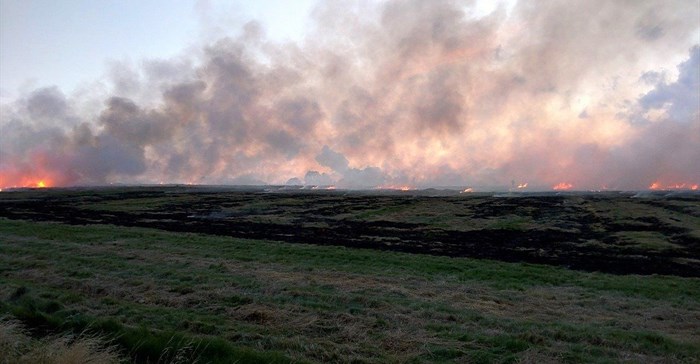About 200,000 hectares of agricultural land have been burnt down in veld fires that raged in the western parts of the Free State over the past two weeks and are described as the worst fires in recent years. The fires led to the loss of hundreds of livestock and game, as well as damage to infrastructure.
Affected producers in the area are probably still recovering from the effects of the 2015/16 drought and may now find themselves in an even worse situation.
This is a difficult time of year when green pastures are not yet available, the available residue has already been utilised, and many cattle farmers’ cows are currently calving. Dry grazing on its own does not adequately provide for the extra needs of cows to take care of their calves; therefore, producers make use of production licks or supplementary feeding until the pasture – usually only after good rains – can meet the requirements.
Affected producers will now not only have to supplement the shortages, but also bring in fodder to fill the gap of the burnt-down pasture. Should cows with calves lose much condition now, the re-conception rates of the animals will also decrease, meaning fewer calves in the next season.
Actual cost of the losses
To calculate the direct cost of losses (animals burnt to death), the market value (slaughter value) can be used. This method may lead to overvaluation because animals are not always market-ready, but it can also lead to undervaluation because the future potential of the animals is not taken into account.
To establish the real value of the losses, one has to look at the indirect costs to determine the total value of the livestock and game that were lost. Possible indirect costs to be considered include the future potential of the animals that could have contributed to herds. The producers have now not only lost part of their existing ‘factory’ on the farm, but also part of their next harvest (calves and lambs), as well as part of their replacement heifers and ewes.
Furthermore, the animals that have been lost were already adapted to the environment and would have produced better than when new livestock is brought into the environment. Other indirect costs that may be considered in determining the total cost of losses, could include the labour costs and other inputs that have already been spent on the livestock, but which would now be unable to yield a return. In addition, the possible lower production from the remaining herd must also be taken into account, where lower calving/lambing percentages or weaker weaning weights may result due to lack of adequate feeding.
The full effect of the fires will therefore not be visible now and producers will only experience the full impact later.
Current problems
One difference between fires and droughts is the fact that fires wipe out the existing grazing immediately, while droughts offer more time to plan as the situation becomes worse. The procurement of feeding for the remaining livestock is likely to be the biggest problem for producers in the affected areas. A producer whose entire farm has burnt down will have to buy all his feed, which would result in further costs.
Should a producer sell his entire herd at this stage, it would be difficult to get the farm back to full capacity once the grazing has recovered. It should also be kept in mind that there would not immediately be grass in the field when it starts raining. The other option is to move livestock to alternative hired grazing, which would in turn increase costs. Producers with mortgages on their farms would still have to pay their instalments, but with the increased input costs, will be under tremendous pressure to still show a profit.
Agriculture is playing a major role in the economic activities of most rural towns in South Africa. When agricultural producers are affected, it may lead to possible job losses for farmworkers and their dependents. All of this is leading to fewer rands being pumped into the local economy. The impact of the fires therefore does not stop at the farm gate and may exacerbate the levels of unemployment and poverty in the affected areas.
How you can help
Several institutions and organisations have already initiated actions to collect donations and contributions for the affected producers. If you feel that you would also like to make a contribution, please make sure that you give your contribution to a reputable organisation.
In closing
The livestock industry started to show signs of moving into a herd-building phase earlier this year, for the very reason that the national herd was killed off during the drought. The increased demand means that livestock (sheep, cattle, and goats), especially breeding material, are now worth more, which also makes the impact of the fires much worse.






























![Today, Halo and Demographica announce a new specialist agency, Second Rodeo]], headed up by Mike Stopforth (left). Dean Oelschig, managing partner and founder of Halo (right) says they will work as a group but ultimately, each agency will be an individual specialist](https://biz-file.com/c/2505/772543-64x64.jpg?2)


